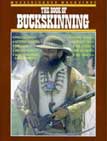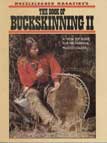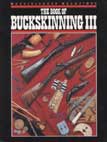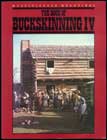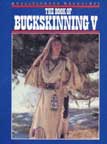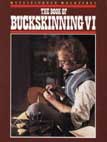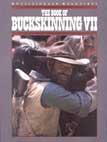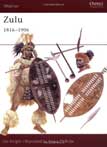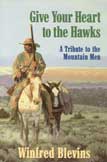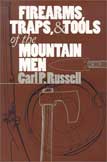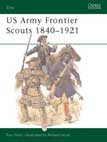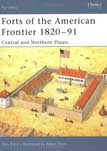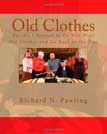

Step back in time and learn how to relive the American frontier. First published in 1981, this bestseller is the standard against which other frontier living history books are judged! Ten authors bring their expertise to the subjects of: The Philosophy of Buckskinning, How to Get Started, Rendezvous & Shoots, The Lodge, The Guns, The Clothing, Accoutrements & Equipment, The Skills, Women in Buckskinning, and The Crafts. Timeless information and inspiration for modern-day frontiersmen and women!
In-depth information on recreating life on the American frontier. Expand your enjoyment of living history with chapters including: Horseback Travel, Powder Horns, Canoeing, Camp Gear, Leather Clothing and Gun Tune-Up & Care. Each chapter was written by an experienced and knowledgeable participant in frontier reenacting. Lavishly illustrated with photographs and line drawings.
Explore recreating life on the American frontier. Solid information shared by knowledgeable and experienced reenactors help modern-day frontiersmen get started in the sport known as buckskinning. Subjects include: Historic Guns & Today's Makers, Quillworking, Trade Beads, 18th & 19th Century Cooking, The Hunting Pouch, Beadworking, Techniques for Making Footwear, and Period Shelters. Special color section of beadwork, quillwork, authentic frontier clothing, and trade bead photos
Enhance your frontier skills and knowledge. Each chapter was written by a knowledgeable and experienced participant in the sport known as buckskinning and lavishly illustrated with photos and drawings. Chapters include: Traditional Blacksmithing, Blankets in Early America, From Raw Hides to Rawhide, Styles of the Southwest, Smoothbores on the Frontier, Trade Silver, Backwoods Knives, Lighting the Primitive Camp, and Historic Sites & Museums. Emphasis is on demonstrating skills and how-to information.
Practical frontier American skills and knowledge are the focus in part five of this series on the sport known as buckskinning. Each chapter was written by a different author with in-depth knowledge of his or her topic. Chapters include: Fur Trade Indian Dresses; Old-Time Music & Instruments; Trade Goods for Rendezvous; Tipi Know-How; Engraving & Carving; Historic Sites & Museums II; Games, Sports & Other Amusements; and Pack Saddles & Panniers. Special color section features the dress of fur trade Indian women and horseback photos. Each chapter is abundantly illustrated with photos and drawings.
Hands-on frontier skills and in-depth historical information. Part six in this bestselling series on the pastime of recreating the American frontier, known as buckskinning, features more first-rate historical information and clear, hands-on instructions in the skills and crafts of the American pioneers. Chapters include: The Traditional Hunting Pouch, Horse Gear-East & West, Making a Wooden Bow, American Powder Horns, Frontier Trail Foods, Old-Time Shooting Matches, Period Trekking, and Finger Weaving. Special color section features photos of period horseback trips, powder horns, hunting pouches, and finger-woven sashes.
Best-selling guide to skills and crafts of frontier America. This book on the pastime of recreating the American frontier, known as buckskinning, continues the tradition of passing along accurate, practical information for the modern-day historian and reenactor. First-rate historical research and hands-on crafts include: Clothing of the Rocky Mountain Trapper, 1820-1840; Indian-Influenced Woodsmen of the Cane; Tools & Techniques of Bark Tanning; A Wardrobe for the Frontier Woman, 1780-1840; A Typical Day's Journey in Winter; Goods of the Trunk Maker & His Trade; Art & Writing on the Frontier; and Great Lakes & Eastern Woodlands Knife Sheaths. Includes a special color section featuring original art and artifacts plus reproductions. Each chapter was written by a knowledgeable participant in his field and is fully illustrated with photos and drawings.
Zulu military organisation was extremely sophisticated. Warriors were organised into regiments with some form of basic uniform and shields were state-manufactured and owned. Yet, in spite of this sophistication, much of the Zulu's military outlook was extremely primitive: firearms were ill understood, and between 1816 and 1906 the Zulus maintained their primary reliance on hand-to-hand fighting. In this book Ian Knight investigates Zulu weaponry in detail, and also their society, beliefs and rituals, particularly with regard to ceremonies conducted before and after battles. Tactics, costume and customs are carefully examined, as are various battles, such as the war between the Zulus and Boers (1838) and the Anglo-Zulu War (1879), which brought about the end of the Zulu kingdom, making this a thorough account of the Zulu warrior.
Blevins portrays the incredible lives of such men as Jed Smith, Jim Bridger, Tom Fitzpatrick, and Bill Williams, while he looks for the greater story, the story of their experiences, rather than the political realities of their era.
In the spring of 1832, 275 Illinois militiamen under the command of Major Isaiah Stillman were sent on a mission to capture or destroy the infamous Chief Black Hawk and subdue the warriors that followed him into Illinois to reclaim their homeland. Stillman’s expedition earned the title of the “Forlorn Hope,” as they found themselves up against superior numbers of warriors with the very real possibility of being completely wiped out. A small contingent of Rangers held their ground and covered the retreat of their fellow Rangers. Many lost their lives, but many others lived to tell the truth about what had really occurred on that day. Last Stand at Old Man’s Creek is the true and correct story of what occurred and the aftermath of the battle that would smear the names of the men who were there. This finally answers the questions that have lingered for nearly two centuries about the circumstances surrounding the surprising defeat of the militia on that fatal day.
This encyclopedic guide to the equipment of the trappers and fur traders who opened the Old West is a unique reference work that can be classified either as history or as archaeology. It describes and discusses hundreds of iron artifacts—rifles, shotguns, hatchets, axes, knives, traps, and miscellaneous tools—used by the mountain men from the early 1800s to the mid 1840s.
Thirty years’ research went into the writing of this book. In addition to examining the diaries and letters of the trappers themselves, and the business records of fur-trading companies, the author also tracked down the records and catalogs of the gunsmiths, ironmongers, and other manufacturers who supplied the early traders. He observed most of the surviving artifacts, identified their makers, and traced the evolution of the styles and designs of the weapons and tools, usually from European origins.
Illustrated with over 400 drawings, the book begins with a useful background history of the western fur trade. Among the sections that will appeal to special groups of readers are chapters on firearms and blacksmithing and an appendix on the “Historic Objects as Sources of History.”
The role of the Frontier scout in the US Army during the period of westward expansion, was often far more important than that of the commanding officer. They possessed a priceless knowledge of the geography, people and characteristics of the great, unknown American hinterland and from the earliest days of exploration, the US Army depended on its scouts to guide troops across the plains and through the mountains as they guarded the nation's frontier settlements. This book tells the colourful story of these frontier men, covering many famous scouts such as 'Wild Bill' Hickok and 'Buffalo Bill' Cody.
A major period of westward expansion took place in the United States during the first half of the 19th century. Fur trading, the coast-to-coast railroad, the California gold rush and the removal of Native American tribes both facilitated and encouraged America's "manifest destiny" to become a transcontinental nation. The task of protecting the settlers from the tribes that inhabited the Great Plains fell to the US Army, and to do this an extensive network of permanent forts was created via construction and acquisition. This title examines why the forts were built, as well as their design, defensive features and the role they played in the settlement of the American West. The daily lives of the garrison soldiers and fort inhabitants are also covered, together with the fighting witnessed at key sites.
This book is an indispensable guide to the often misunderstood field of living history. It presents the actuality that there is a great deal more involved in this discipline than merely “wearing old clothes and going back to the past.” This volume succinctly captures the perspectives that Richard Pawling has gained from over thirty-five years of experience in the interpretive profession (in county, state and national parks and as entrepreneur and owner of Rich Pawling’s History Alive!). Here, Pawling shares his observations and advice about everything from designing a living history persona to his successful use of this provocative teaching technique in the college classroom, to the role of research in helping you to learn about your own genealogical past. Though written for a broad audience, this book should be of particular interest to those employed as an interpretive park ranger or a naturalist, a museum or tour guide, or those who volunteer as a military reenactor or as a docent at a park, museum or historic site. Old Clothes presents the important lessons Pawling has learned along the way, the most important of which is that “life is a journey and understanding our past plays an important role in helping us to continue to learn not only about life in general, but more importantly, about ourselves.”
Pope Julius II excommunicates Italian state of Venice
Treaty of St. Truiden: anti-French Trapdoors / Bourgondisch covenant
Battle at Bicacca: Charles I and Pope Adrianus VI beat France
Mogol King Babur beats Sultan of Delhi
1st Spanish settlement in Philippines, Cebu City, forms
Peace of Beaulieu and Paix de Monsieur
King Charles I flees Oxford
Scottish general Montrose defeated
Netherlands and France sign military covenant
Frederik August I "the Strong" becomes Monarch of Saksen
Battle at Culloden Moor: Duke of Cumberland beats "James VIII & III"
US Marines attack shores of Tripoli
Americans under General Pike capture Toronto; Pike is killed
Fire destroys half of Charleston
Imakita Kosen, 1st Zen teacher of D.T. Suzuki, found the awakening
Establishment of Jewish congregations in Lower Austria prohibited
"Pomona" sinks in North Atlantic drowning all 400 aboard
Thomas J Jackson is assigned to command Harpers Ferry
President Abe Lincoln suspends writ of habeas corpus
West Virginia secedes from Virginia after Virginia secedes from US
Cornell University (Ithaca NY) is chartered
Heinrich Schliemann discovers Troi
White League, Paramilitary white supremacist organization, forms
Opera "Le Roi de Lahore" is produced (Paris)
President Hayes removes Federal troops from LA, Reconstruction ends
Pogroms against Russian Jews start in Elisabethgrad
1st Highlander (Yankee) shut-out, Philadelphia Athletics win 6-0
World Exposition opens in Luik
Sultan of Turkey Abdul Hamid II is overthrown
Belgian parliament rejects socialist motion for general voting rights
Relief laws replaces those of 1854, in the Netherlands
Pogrom leader Petljoera declares Ukraine Independence
Hadjememaar, [Corn de Gelder] elected in Amsterdam
Fritz Langs "Dr Mabuse, der Spieler" premieres in Berlin
Yakut ASSR formed in Russian SFSR
Mussolini government italian place in South Tirol / Alto Adige
Antwerp soccer tie Belgium-Netherlands 1-1
Karl Jansky reports reception of cosmic radio signal in Washington DC
Yanks pull a 1st inning triple-play and beat Philadelphia Athletics 9-8
1st US social security payment made
US Social Security system makes its 1st benefit payment
Himmler orders establishment of Auschwitz Concentration Camp
German troops occupy Athens Greece
Belgium Jews are forced to wear stars
Tornado destroys Pryor Oklahoma killing 100, injuring 300
Lou Jansen and Jan Dieters arrested, lead illegal CPN party in Holland
Soviet Union breaks contact with Polish government exiled in London
Boston Brave Jim Tobin no-hits Brooklyn Dodgers, 2-0
2nd Republic of Austria forms
Italian partisans capture Mussolini prisoner
US 5th army enters Genua
1st radar installation aboard a coml ship installed
Babe Ruth Day celebrated at Yankee Stadium and through out US
Arab legion attacks Gesher bridge on Jordan River
"Tickets, Please" opens at Coronet Theater NYC for 245 performances
South Africa passes Group Areas Act segregating races
Mohammed Mossadeq chosen Premier of Persia
"4 Saints in 3 Acts" closes at Broadway Theater NYC after 15 performances
1st general elections in British Guyana, won by Jagans PPP
Wrestler Freddie Blassie coins term "Pencil neck geek"
Heavyweight champ, Rocky Marciano, retires undefeated from boxing
"Today" show goes abroard 1st time (Paris France)
Liu Sjau-chi elected President of China PR
1st atomic powered electric-drive submarine launched (Tullibee)
South Korean President Syngman Rhee resigns
Togo (formerly French Togo) declares independence from French adm
NASA launches Explorer 11 into Earth orbit to study gamma rays
NFL officially recognizes Hall of Fame in Canton, Ohio
Sierra Leone declares independence from the UK
"Jopie" Pengel forms government in Suriname
Cuban Premier Fidel Castro arrives in Moscow
RC Duncan patents "Pampers" disposable diaper
Dmitri Shostakovitch completes his 2nd cello concert
Rocky Marciano retires as undefeated boxing champ
"Education of Hyman Kaplan" closes at Alvin NYC after 28 performances
Baltimore Oriole Tom Phoebus no-hits Boston, 6-0
Congress of Political Party Radicals (PPR) forms in the Netherlands
Carol Mann wins LPGA Raleigh Ladies Golf Invitational
Curt Flood resigns Senators after 13 games and departs for Denmark
Apollo 16 returns to Earth
New York City Mayor John Lindsey appeals that John Lennon not be deported
Kansas City Royal Steve Busby no-hits Detroit Tigers, 3-0
Pan Am 707 crashes into mountains of Bali, killing 107
Sandra Haynie wins LPGA Charity Golf Classic
"So Long 174th St" opens at Harkness Theater NYC for 16 performances
Arabic Monetary Fund established in Abu Dhabi
Bloody riots in Soweto South Africa
HCC, Hobby Computer Club, forms in the Netherlands
Accident at nuclear reactor Willow Island, W Virginia, kills 51
George Harrison releases "Love Comes to Everyone"
Barbara Barrow wins LPGA Birmingham Golf Classic
1st female soccer official is hired by NASL
Beatle Ringo Starr marries actress Barbara Bach [Goldbach]
Nordiques 1-Isles 4 - Semifinals - Isles hold 1-0 lead
Trial of John W Hinckley Jr attempted assassin of Reagan, begins
Nolan Ryan becomes strikeout King (3,509), passing Walter Johnson
Cleveland Indians beat Detroit Tigers, 8-4, in 19 innings
Over 70 inches of snow falls on Red Lake, Montana
"Sweet Charity" opens at Minskoff Theater NYC for 368 performances
Captain Midnight (John R MacDougall) interrupts HBO
Pat Bradley wins LPGA S&H Golf Classic
US Justice Department bars Austrian Chancellor Kurt Waldheim from entering US, due to his aid of Nazi Germany during WWII
"Starmites" opens at Criter Ctr SR Theater NYC for 60 performances
Beijing students take over Tiananmen Square in China
Hurricane in Bangladesh, kills 500
Mandatory seatbelt law goes into effect in Italy
50th annual barbershop quartet singing convention held (Mich)
Dodger Orel Hershiser undergoes career-threatening shoulder surgery
Firestone World Bowling Tournament of Champions won by David Ozio
"Small Family Business" opens at Music Box Theater NYC for 48 performances
New York Jets finish perfect 5-0 pre-season for 1st time
New York Mets trade David Cone to Toronto Blue Jays for Jeff Kent
Afghan Antonov AN-32 crashes at Tashqurgan, kills 76
"Inspector Calls" opens at Royale Theater NYC for 454 performances
7th longest NHL game: New Jersey Devils beat Buffalo Sabres (125 min 43 seconds)
Graeme Obree bicycles world record time (52,713 km)
President Nixon buried in Nixon Library in California
Twins righty Scott Erickson no-hits Brewers 6-0
"Indiscretions" opens at Ethel Barrymore Theater NYC for 221 performances
Coors Field in Colo opens - Denver Rockies beats Mets 11-9 in 14
"Little Foxes, " opens at Vivian Beaumont NYC for 56 performances
"Stanley, " closes at Circle in the Square Theater, New York City
Frank Nobilo wins Greater Greensboro Chrysler Classic at Forest Oaks
Las Vegas Senior Golf Classic by TruGreen-ChemLawn
Nancy Lopez wins LPGA Chick-fil-A Charity Championship
